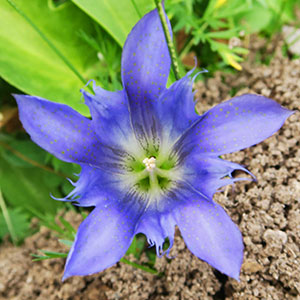Gentiana newberryi
Gentiana pennelliana
alpine gentian, Newberry's gentian
wiregrass gentian
1–5, arising laterally below rosettes, from a stout tap root, tufted, decumbent.
1, terminal from caudex, decumbent.
basal and cauline;
blades of basal rosette and proximal cauline leaf blades widely spatulate to obovate or oblanceolate, 0.8–5 cm × 2–25 mm, apex obtuse or mucronate, at least these leaves with blades less than 6 times as long as wide, distal cauline leaves few, with blades oblanceolate to lanceolate or linear, 2–5 cm × 2–5 mm, apices acute.
all cauline, gradually more distantly spaced distally;
blade linear to narrowly oblanceolate, 1–3.5 cm × 0.5–5 mm, apex obtuse (proximal leaves) to acute.
terminal, flowers usually solitary, occasionally 2 or 3.
solitary flowers.
calyx 14–30 mm, lobes linear to narrowly ovate, (4–)6–12 mm, margins not ciliate;
corolla white or blue, campanulate, open, 23–55 mm, lobes spreading, elliptic-obovate, 7–17 mm, free portions of plicae divided into 2 triangular, serrate to lacerate segments;
anthers distinct.
calyx 18–45 mm, lobes linear, 10–30 mm, margins not ciliate;
corolla white with greenish purple lines abaxially on and below lobes, funnelform, open, 35–65 mm, lobes spreading, ovate, 15–25 mm, free portions of plicae deeply divided into 2 subequal, lacerate, attenuate segments;
anthers distinct.
winged.
winged.
Gentiana newberryi
Gentiana pennelliana
Varieties 2 (2 in the flora).
The two varieties of Gentiana newberryi intergrade extensively. The most distinctive form of var. newberryi, with relatively tall stems and medium to deep blue corollas, occurs in the northern part of the range of the species, from the Klamath and White mountains of California north into Oregon. Plants most clearly referable to var. tiogana prevail in the southern part of the range of the species, from Butte County south to Inyo and Tulare counties, California. In the central part of the range of the species, plant size and corolla color are less consistently correlated, with occasional plants combining low stature with deep blue corollas or tall stems with predominantly white or pale blue corollas. In that part of the range, corolla color may be highly variable within a single population.
The leaves of Gentiana newberryi are thick-textured and distinctively concave, usually spoon-shaped, when fresh. Narrower leaves sometimes occur in var. tiogana, but many plants of that variety have widely spatulate leaves like those of var. newberryi.
(Discussion copyrighted by Flora of North America; reprinted with permission.)
Gentiana pennelliana is endemic to Bay, Calhoun, Franklin, Gadsden, Gulf, Leon, Liberty, Wakulla, and Walton counties in northern Florida. It usually grows in plant communities in which wiregrass, Aristida stricta, is a prominent component, hence the common name.
Gentiana pennelliana differs further from G. autumnalis in its longer, more gradually flaring corolla tube; the division of the lateral veins of the corolla near the base, so that each petal has five primary veins rather than three as in G. autumnalis and the other Gentiana species in the flora area; and stamens 7–12 mm above their insertion on the corolla tube, as contrasted with 13–30 mm in G. autumnalis.
(Discussion copyrighted by Flora of North America; reprinted with permission.)
1. Corollas medium to deep blue with greenish to dark purple lines abaxially on and below lobes, usually 35–55 mm. | var. newberryi |
1. Corollas white to pale blue except for greenish to dark purple lines abaxially on and below lobes, usually 23–42 mm. | var. tiogana |


